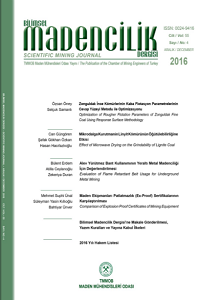Comparison of Conditioned Radial Bases Function Approach and Kriging: Estimation of Calorific Value in a Coal Field
Comparison of Conditioned Radial Bases Function Approach and Kriging: Estimation of Calorific Value in a Coal Field
Due to low production cost, coal is still the most important source of electricity production worldwide. This important position of coal also makes the evaluation of coal resources important. One of the most important attributes to be assessed in this evaluation is estimating the calorific value distribution of deposit. In geostatistical estimation currently Kriging and its variants are being used widely. Alternatively new techniques are being developed and one of them is the Radial Based Functions based method. In this study, Conditioned Radial Basis Function (CRBF) is used to estimate the calorific value distribution of a coal deposit while estimations are also performed with Ordinary Kriging (OK). Results of both estimation methods are compared with respect to composite calorific values. Results show that CRBF produced a higher estimation range than OK with closer mean to composite. However, like OK, results are still smoother than the composite values.
Keywords:
Coal, Radial basis function Kriging,
___
- References Afzal P. (2018) Comparing ordinary kriging and advanced inverse distance squared methods based on estimating coal deposits; case study: East-Parvadeh deposit, central Iran. J Min Environ 9:753–760
- Atalay F, Tercan A.E. (2017) Coal resource estimation using Gaussian copula. Int J Coal Geol 175:1–9
- Atalay, F., Ünal, M. S., & Kıllıoğlu, S. Y. (2021). Comparison of Radial Basis Function and Ordinary Kriging Estimations in an Iron Ore Deposit. Avrupa Bilim ve Teknoloji Dergisi, (27), 303-310 (In Turkish). http:- doi.org/10.1016/j.coal.2017.03.010
- Cressie N. (1990) The origins of kriging. Math Geol 22:239–252 Chelgani, S. C. (2021). Estimation of gross calorific value based on coal analysis using an explainable artificial intelligence. Machine Learning with Applications, 6, 100116. DOI: doi.org/10.1016/j.mlwa.2021.100116
- Demirel I.H., Sarac C., Sen O. (2000) Geostatistical reserve estimation: A case study in the Canakci coal seam of Ermenek Basin, Turkey. Energy sources 22:925–933
- Ertunc G., Tercan A.E., Hindistan M. A., Ünver, B., Ünal S., Atalay F., Kıllıoğlu S.Y., (2013) Geostatistical estimation of coal quality variables by using covariance matching constrained kriging. Int J Coal Geol 112:14–25. https://doi.org/10.1016/j.coal.2012.11.014
- Fang J.H., Starks T.H., Mattern J. (1980) Geostatistical Approach in Coal Resource Estimation. AAPG Bulletin 64:705
- Hardy R. L. (1971), Multiquadratic equations of topography and other irregular surfaces, J. Geophys. Res., 76, pp. 1905-1915
- Inaner H., Nakoman E., Karayigit A.I. (2008), Coal resource estimation in the Bayir field, Yatagan-Mugla, SW Turkey. Energy Sources, Part A 30:1005–1015
- Jeuken R., Xu C., Dowd P. (2020) Improving Coal Quality Estimations with Geostatistics and Geophysical Logs. Nat Resour Res 1–18 https://doi. org/10.1007/s11053-019-09609-y
- Journel A.G., Huijbregts C.J. (1978) Mining geostatistics. Academic press London
- Myers D.E. (1992) Kriging, cokriging, radial basis functions and the role of positive definiteness. Comput Math with Appl 24:139–148
- Olea, R. A., Luppens, J. A., & Tewalt, S. J. (2011). Methodology for quantifying uncertainty in coal assessments with an application to a Texas lignite deposit. International Journal of Coal Geology, 85(1), 78-90. https://doi.org/10.1016/j.coal.2010.10.001
- Olea R.A. (2012) Geostatistics for engineers and earth scientists. Springer Science & Business Media
- Orr M.J.L., (1996), Introduction to radial basis function networks, Centre for cognitive sciences, University of Edinburgh, Pardo-Igúzquiza E., Dowd P.A., Baltuille J.M., Chica-Olmo M. (2013) Geostatistical modelling of a coal seam for resource risk assessment. Int J coal Geol 112:134–140
- Rossi M.E., Deutsch C. V. (2013) Mineral resource estimation. Springer Science & Business Media
- Rossi M.E., Deutsch C. V. (2014) Spatial Variability in Mineral Resource Estimation. Springer, pp 97–116
- Schaback, R., Wendland, H. (2001). Characterization and construction of radial basis functions. Multivariate approximation and applications, 1-24.
- Schagen, I. P. (1979). Interpolation in two dimensions—a new technique. IMA Journal of Applied Mathematics, 23(1), 53-59.
- Sideri D., Roumpos C., Pavloudakis F., et al (2020) Multivariate Geostatistical Modeling of Lower Calorific Value in Multi-Seam Coal Deposits. Appl Sci 10:6208 https:// doi.org/10.3390/app10186208
- Srivastava R.M. (2013) Geostatistics: a toolkit for data analysis, spatial prediction and risk management in the coal industry. Int J Coal Geol 112:2–13
- Stein M.L. (2012) Interpolation of spatial data: some theory for kriging. Springer Science & Business Media
- Tercan A.E. (2004) Global recoverable reserve estimation by covariance matching constrained kriging. Energy sources 26:1177–1185
- Tercan A.E., Karayigit A.I. (2001) Estimation of lignite reserve in the Kalburcayiri field, Kangal basin, Sivas, Turkey. Int J Coal Geol 47:91–100,
- Tercan A.E., Ünver B., Hindistan M.A., (2013) Seam modeling and resource estimation in the coalfields of western Anatolia. Int J Coal Geol 112:94– 106 Turkish Coal Enterprises, (2021) Coal Sector Report, 119 pages. Thomas L. (2013) Coal geology. Wiley Online Library Whateley, M. K. G., İnaner, H., Nakoman, E., & Mulcahy, S. (1997). Comparison of classical and geostatistical methods for coal resource estimation in the Turgut Deposits, Muğla-Yatağan, SW Turkey. In European Coal Geology, Proceeding 3rd European Coal Conference (pp. 559- 572).
- ISSN: 2564-7024
- Başlangıç: 1960
- Yayıncı: TMMOB Maden Mühendisleri Odası
